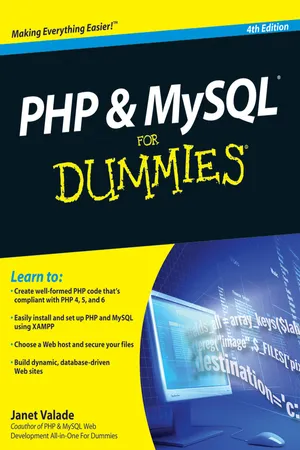
- English
- ePUB (mobile friendly)
- Available on iOS & Android
PHP and MySQL For Dummies
About this book
Here's what Web designers need to know to create dynamic, database-driven Web sites
To be on the cutting edge, Web sites need to serve up HTML, CSS, and products specific to the needs of different customers using different browsers. An effective e-commerce site gathers information about users and provides information they need to get the desired result.
PHP scripting language with a MySQL back-end database offers an effective way to design sites that meet these requirements. This full updated 4th Edition of PHP & MySQL For Dummies gets you quickly up to speed, even if your experience is limited.
- Explains the easy way to install and set up PHP and MySQL using XAMPP, so it works the same on Linux, Mac, and Windows
- Shows you how to secure files on a Web host and how to write secure code
- Packed with useful and understandable code examples for Web site creators who are not professional programmers
- Fully updated to ensure your code will be compliant based on PHP 5.3 and MySQL 5.1.31
- Provides clear, accurate code examples
PHP & MySQL For Dummies, 4th Edition provides what you need to know to create sites that get results.
Note: CD-ROM/DVD and other supplementary materials are not included as part of eBook file.
Frequently asked questions
- Essential is ideal for learners and professionals who enjoy exploring a wide range of subjects. Access the Essential Library with 800,000+ trusted titles and best-sellers across business, personal growth, and the humanities. Includes unlimited reading time and Standard Read Aloud voice.
- Complete: Perfect for advanced learners and researchers needing full, unrestricted access. Unlock 1.4M+ books across hundreds of subjects, including academic and specialized titles. The Complete Plan also includes advanced features like Premium Read Aloud and Research Assistant.
Please note we cannot support devices running on iOS 13 and Android 7 or earlier. Learn more about using the app.
Information

Table of contents
- Cover
- Table of Contents
- Title Page
- Introduction
- Part I: Developing a Web Database Application Using PHP and MySQL
- Part II: MySQL Database
- Part III: PHP
- Part IV: Applications
- Part V: The Part of Tens
- Part VI: Appendixes